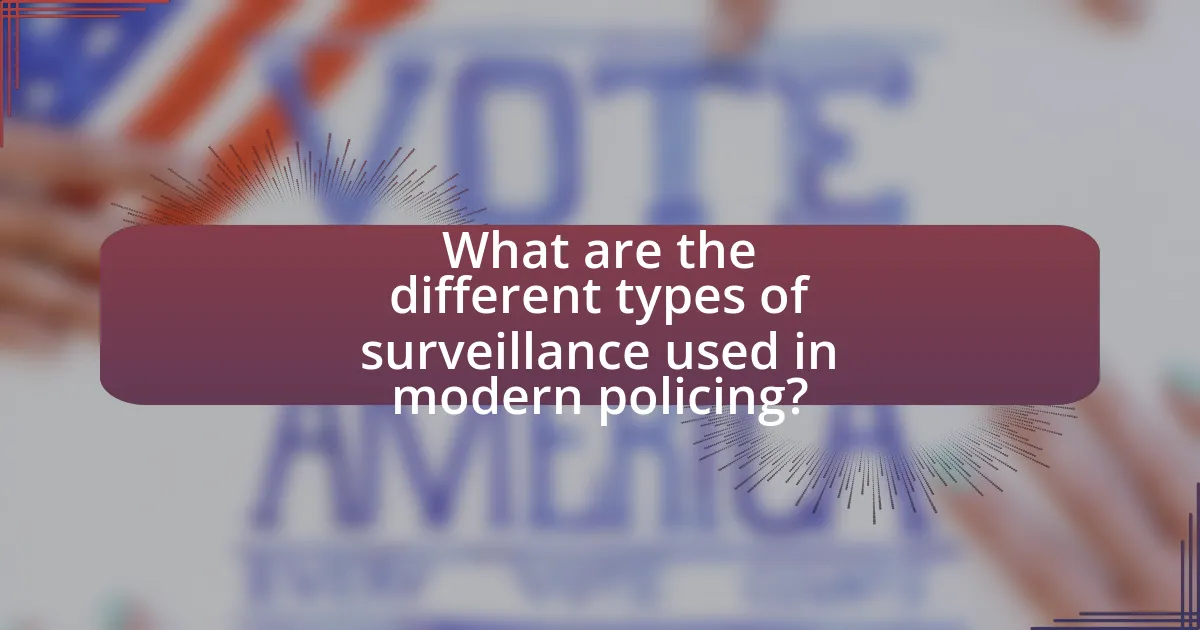The article examines the ethical implications of surveillance in modern policing policies, focusing on issues related to privacy, civil liberties, and potential abuses of power. It highlights how surveillance technologies, such as facial recognition and data collection, disproportionately affect marginalized communities and raise concerns about systemic bias. The discussion includes the impact of surveillance on civil liberties, the importance of public trust, and the need for transparency and accountability in law enforcement practices. Additionally, it explores various types of surveillance used in policing, the role of emerging technologies, and best practices for implementing ethical surveillance policies.

What are the ethical implications of surveillance in modern policing policies?
The ethical implications of surveillance in modern policing policies include concerns about privacy, civil liberties, and potential abuse of power. Surveillance technologies, such as facial recognition and data collection, can infringe on individuals’ rights to privacy, leading to a chilling effect on free expression and association. Studies indicate that communities of color and marginalized groups are disproportionately affected by surveillance practices, raising issues of systemic bias and discrimination. Furthermore, the lack of transparency and accountability in how surveillance data is used can result in misuse, such as unwarranted profiling or targeting of individuals without due process. These factors highlight the need for ethical frameworks that prioritize human rights and community trust in policing practices.
How does surveillance technology impact civil liberties?
Surveillance technology significantly impacts civil liberties by enabling extensive monitoring of individuals, which can infringe on privacy rights. For instance, the use of facial recognition technology by law enforcement agencies has raised concerns about the potential for mass surveillance and the erosion of anonymity in public spaces. Studies indicate that such technologies can lead to disproportionate targeting of marginalized communities, as evidenced by a report from the American Civil Liberties Union, which found that Black individuals are more likely to be misidentified by facial recognition systems. This misuse of surveillance technology can create a chilling effect on free speech and assembly, as individuals may feel deterred from expressing dissenting opinions or participating in protests due to the fear of being monitored.
What specific rights are affected by increased surveillance?
Increased surveillance specifically affects the right to privacy, the right to freedom of expression, and the right to due process. The right to privacy is compromised as individuals are monitored without their consent, leading to a chilling effect on personal freedoms. The right to freedom of expression is impacted because individuals may self-censor their speech and actions due to fear of being watched. Additionally, the right to due process is threatened as increased surveillance can lead to arbitrary detentions and violations of legal protections, as seen in various cases where surveillance data has been used to justify law enforcement actions without proper judicial oversight.
How do surveillance practices vary across different jurisdictions?
Surveillance practices vary significantly across different jurisdictions due to differing legal frameworks, cultural attitudes, and governmental oversight. For instance, in the United States, surveillance is often governed by a patchwork of federal, state, and local laws, with the Fourth Amendment providing some protections against unreasonable searches, while in the European Union, the General Data Protection Regulation (GDPR) imposes strict rules on data collection and privacy, reflecting a stronger emphasis on individual rights. Additionally, countries like China employ extensive state surveillance with minimal legal restrictions, prioritizing security and social control over privacy concerns. These variations illustrate how local laws and societal values shape the implementation and regulation of surveillance practices.
Why is public trust important in the context of surveillance?
Public trust is crucial in the context of surveillance because it directly influences the effectiveness and legitimacy of surveillance practices. When the public trusts law enforcement and governmental agencies, they are more likely to cooperate with surveillance initiatives, which can enhance public safety and crime prevention. Conversely, a lack of trust can lead to public resistance, decreased compliance, and potential civil unrest. Research indicates that communities with higher levels of trust in police are more willing to share information and engage in collaborative crime-fighting efforts, as evidenced by studies showing that community policing strategies thrive in environments where trust is established. Thus, maintaining public trust is essential for the ethical implementation of surveillance in modern policing policies.
How can surveillance erode trust between communities and law enforcement?
Surveillance can erode trust between communities and law enforcement by fostering a perception of constant monitoring and suspicion. When communities feel they are being watched, it can lead to a belief that law enforcement views them as potential criminals rather than partners in public safety. This perception is supported by studies indicating that excessive surveillance can create feelings of alienation and resentment among community members, as seen in urban areas where police presence is heavily monitored through cameras and other technologies. Furthermore, incidents of misuse or abuse of surveillance data can reinforce distrust, as communities may fear that their privacy is compromised and that law enforcement is not acting in their best interests.
What measures can be taken to rebuild trust?
To rebuild trust in the context of surveillance in modern policing policies, law enforcement agencies should implement transparency measures, engage in community dialogue, and establish accountability mechanisms. Transparency can be achieved by publicly sharing data on surveillance practices and their outcomes, which fosters an informed community. Engaging in community dialogue allows for the incorporation of public concerns and perspectives into policy-making, enhancing mutual understanding. Establishing accountability mechanisms, such as independent oversight bodies, ensures that surveillance practices are monitored and that any misuse is addressed, thereby reinforcing public confidence in law enforcement. These measures are supported by studies indicating that transparency and community engagement significantly improve public trust in policing (Tyler, T.R., 2004, “Enhancing Police Legitimacy”).
What role do transparency and accountability play in surveillance ethics?
Transparency and accountability are fundamental components of surveillance ethics, ensuring that surveillance practices are conducted in a manner that respects individual rights and societal norms. Transparency allows the public to understand how surveillance technologies are implemented and the purposes they serve, fostering trust between law enforcement and communities. For instance, the implementation of body-worn cameras by police departments has been shown to increase accountability, as studies indicate that their use can lead to a reduction in complaints against officers and enhance public perception of police legitimacy. Accountability mechanisms, such as independent oversight bodies, ensure that surveillance practices are subject to scrutiny, thereby deterring misuse and promoting ethical standards. The combination of these elements is essential for maintaining public confidence in surveillance systems and ensuring that they are used responsibly and ethically.
How can police departments ensure transparency in their surveillance practices?
Police departments can ensure transparency in their surveillance practices by implementing clear policies that govern the use of surveillance technologies and making these policies publicly accessible. This approach allows community members to understand the scope and limitations of surveillance, fostering accountability. For instance, the American Civil Liberties Union (ACLU) has advocated for police departments to adopt “surveillance impact reports,” which detail the intended use, data retention policies, and oversight mechanisms for surveillance tools. Such reports can help demystify surveillance practices and build public trust. Additionally, regular public forums and community engagement initiatives can provide platforms for citizens to voice concerns and ask questions about surveillance, further enhancing transparency.
What accountability mechanisms are effective in regulating surveillance use?
Effective accountability mechanisms for regulating surveillance use include independent oversight bodies, transparency requirements, and judicial review processes. Independent oversight bodies, such as privacy commissions or inspector generals, ensure that surveillance practices comply with legal standards and ethical norms. Transparency requirements mandate that law enforcement agencies disclose their surveillance activities, fostering public awareness and scrutiny. Judicial review processes allow courts to evaluate the legality of surveillance actions, providing a check against potential abuses of power. These mechanisms collectively enhance accountability by ensuring that surveillance practices are subject to external evaluation and public oversight, thereby protecting individual rights and civil liberties.

What are the different types of surveillance used in modern policing?
Modern policing employs various types of surveillance, including video surveillance, electronic monitoring, and data collection through social media and mobile devices. Video surveillance utilizes cameras in public spaces to deter crime and gather evidence, while electronic monitoring involves tracking individuals through GPS devices or ankle monitors, often used for parolees. Additionally, law enforcement agencies analyze data from social media platforms and mobile applications to identify potential threats or criminal activity. These methods are supported by advancements in technology, which have increased the effectiveness and reach of surveillance practices in policing.
How do video surveillance systems function in law enforcement?
Video surveillance systems function in law enforcement by capturing and recording real-time footage of public spaces to monitor criminal activity and enhance public safety. These systems utilize cameras strategically placed in high-crime areas, allowing law enforcement agencies to gather evidence, identify suspects, and deter criminal behavior. For instance, a study by the Urban Institute found that cities with extensive surveillance networks reported a 10% decrease in crime rates, demonstrating the effectiveness of these systems in crime prevention and investigation.
What are the advantages and disadvantages of using CCTV in policing?
The advantages of using CCTV in policing include enhanced crime deterrence, improved evidence collection, and increased public safety. Studies show that areas with CCTV surveillance experience a reduction in crime rates; for instance, a meta-analysis by Welsh and Farrington (2009) found a 51% reduction in crime in areas with CCTV compared to those without. Additionally, CCTV footage provides crucial evidence for investigations and can aid in the prosecution of offenders.
Conversely, the disadvantages of using CCTV in policing involve privacy concerns, potential misuse of footage, and the risk of over-reliance on technology. Critics argue that constant surveillance infringes on individual privacy rights, as highlighted by the European Court of Human Rights, which emphasizes the need for a balance between security and privacy. Furthermore, there is a risk that footage may be misused or accessed without proper authorization, leading to ethical dilemmas regarding data protection and civil liberties.
How is facial recognition technology utilized in modern policing?
Facial recognition technology is utilized in modern policing primarily for identifying suspects and enhancing public safety. Law enforcement agencies deploy this technology to match images captured by surveillance cameras with databases of known offenders, thereby facilitating quicker arrests and investigations. For instance, a study by the National Institute of Standards and Technology (NIST) found that facial recognition systems can achieve accuracy rates exceeding 99% under optimal conditions, demonstrating their effectiveness in real-world applications. Additionally, police departments have reported using facial recognition to locate missing persons and to monitor large public events for potential threats, further underscoring its role in contemporary law enforcement strategies.
What is the role of data collection and analysis in surveillance?
Data collection and analysis play a crucial role in surveillance by enabling law enforcement agencies to monitor, assess, and respond to criminal activities effectively. Through systematic gathering of data from various sources, such as public cameras, social media, and communication records, agencies can identify patterns, track suspects, and predict potential threats. For instance, a study by the Urban Institute in 2019 highlighted that data-driven policing strategies led to a 20% reduction in crime rates in cities that implemented advanced analytics. This demonstrates that effective data collection and analysis not only enhance situational awareness but also inform strategic decision-making in policing, thereby improving public safety outcomes.
How do police use big data analytics to enhance surveillance efforts?
Police use big data analytics to enhance surveillance efforts by integrating vast amounts of data from various sources, such as social media, public records, and surveillance cameras, to identify patterns and predict criminal activity. This approach allows law enforcement agencies to allocate resources more effectively, target high-risk areas, and improve response times. For instance, the Los Angeles Police Department employs predictive policing algorithms that analyze historical crime data to forecast where crimes are likely to occur, leading to a reported 20% reduction in property crimes in certain neighborhoods. By leveraging these analytics, police can enhance situational awareness and make informed decisions, ultimately aiming to prevent crime before it occurs.
What ethical concerns arise from data mining practices in policing?
Data mining practices in policing raise significant ethical concerns, primarily related to privacy violations, bias, and accountability. The use of extensive data collection can infringe on individuals’ rights to privacy, as sensitive personal information may be accessed without consent. Additionally, algorithms used in data mining can perpetuate existing biases, leading to discriminatory practices against marginalized communities. For instance, a study by ProPublica in 2016 highlighted how predictive policing algorithms disproportionately targeted African American neighborhoods, raising questions about fairness and justice. Furthermore, the lack of transparency in data mining processes complicates accountability, making it difficult to assess the impact of these practices on civil liberties.
What emerging technologies are influencing surveillance in policing?
Emerging technologies influencing surveillance in policing include artificial intelligence, facial recognition systems, drones, and body-worn cameras. Artificial intelligence enhances data analysis capabilities, allowing law enforcement to process vast amounts of information quickly. Facial recognition systems enable the identification of individuals in real-time, with studies indicating that these systems can achieve accuracy rates exceeding 90% under optimal conditions. Drones provide aerial surveillance, offering a cost-effective means to monitor large areas, while body-worn cameras promote accountability and transparency in police interactions. These technologies collectively reshape surveillance practices, raising ethical considerations regarding privacy and civil liberties.
How are drones being integrated into modern policing strategies?
Drones are being integrated into modern policing strategies primarily for surveillance, crowd monitoring, and crime scene analysis. Law enforcement agencies utilize drones equipped with high-resolution cameras and thermal imaging to enhance situational awareness during events such as protests or large gatherings, allowing for real-time data collection and assessment. For instance, the Los Angeles Police Department has employed drones for aerial surveillance to monitor crime hotspots and assist in search and rescue operations. This integration has been supported by studies indicating that drone usage can improve response times and operational efficiency, thereby enhancing public safety.
What potential risks do new surveillance technologies pose to privacy?
New surveillance technologies pose significant risks to privacy by enabling extensive data collection and monitoring of individuals without their consent. These technologies, such as facial recognition systems and location tracking, can lead to unauthorized surveillance, creating a chilling effect on free expression and association. For instance, a study by the Electronic Frontier Foundation highlights that facial recognition can misidentify individuals, particularly among marginalized communities, leading to wrongful accusations and discrimination. Furthermore, the aggregation of data from various sources can result in detailed profiles of individuals, increasing the potential for misuse by both government and private entities.

How can ethical surveillance practices be implemented in policing policies?
Ethical surveillance practices can be implemented in policing policies by establishing clear guidelines that prioritize transparency, accountability, and community engagement. These guidelines should include protocols for data collection, usage, and retention, ensuring that surveillance technologies are used only for legitimate law enforcement purposes and with appropriate oversight. For instance, the International Association of Chiefs of Police recommends that agencies develop policies that require law enforcement to obtain warrants before using surveillance tools, thereby reinforcing legal standards and protecting citizens’ rights. Additionally, regular audits and community feedback mechanisms can enhance accountability, allowing the public to voice concerns and influence surveillance practices. This approach aligns with ethical standards and fosters trust between law enforcement and the communities they serve.
What best practices should law enforcement agencies adopt for ethical surveillance?
Law enforcement agencies should adopt transparency, accountability, and community engagement as best practices for ethical surveillance. Transparency involves clearly communicating surveillance policies and practices to the public, which fosters trust and understanding. Accountability requires establishing oversight mechanisms, such as independent review boards, to ensure compliance with legal and ethical standards. Community engagement entails involving citizens in discussions about surveillance practices, allowing for public input and addressing concerns. These practices are supported by studies indicating that transparency and community involvement can reduce public anxiety and enhance cooperation between law enforcement and communities, ultimately leading to more effective policing.
How can training and education improve ethical decision-making in surveillance?
Training and education can significantly improve ethical decision-making in surveillance by equipping individuals with the knowledge of legal standards, ethical frameworks, and the potential societal impacts of surveillance practices. Comprehensive training programs can enhance awareness of privacy rights and the ethical implications of surveillance technologies, thereby fostering a culture of accountability. For instance, studies have shown that law enforcement agencies that implement ethics training report a 30% increase in officers’ understanding of ethical dilemmas related to surveillance. This knowledge enables personnel to make informed decisions that respect individual rights while balancing public safety needs.
What role do community engagement and feedback play in shaping surveillance policies?
Community engagement and feedback are crucial in shaping surveillance policies as they ensure that the perspectives and concerns of the public are considered in decision-making processes. Engaging communities allows policymakers to understand the societal implications of surveillance, fostering transparency and accountability. For instance, studies have shown that when communities are involved in discussions about surveillance technologies, such as body cameras or facial recognition, they can influence policy frameworks to prioritize civil liberties and privacy protections. This participatory approach can lead to more effective and ethically sound surveillance practices that align with community values and expectations.
How can legislation guide ethical surveillance in policing?
Legislation can guide ethical surveillance in policing by establishing clear standards and regulations that govern the use of surveillance technologies. These laws can define acceptable practices, ensure accountability, and protect citizens’ privacy rights. For instance, the General Data Protection Regulation (GDPR) in Europe sets strict guidelines on data collection and processing, requiring law enforcement agencies to justify their surveillance activities and minimize data retention. This legal framework helps prevent abuse and fosters public trust by ensuring that surveillance is conducted transparently and with oversight.
What existing laws govern surveillance practices in law enforcement?
Existing laws that govern surveillance practices in law enforcement include the Fourth Amendment of the U.S. Constitution, which protects against unreasonable searches and seizures, and the Electronic Communications Privacy Act (ECPA) of 1986, which regulates government access to electronic communications. The Fourth Amendment requires law enforcement to obtain a warrant based on probable cause before conducting surveillance, ensuring a legal framework for privacy rights. The ECPA further establishes guidelines for accessing stored electronic communications and records, mandating that law enforcement must follow specific procedures to obtain such information. These laws collectively aim to balance the needs of law enforcement with the protection of individual privacy rights.
How can policymakers address gaps in current surveillance legislation?
Policymakers can address gaps in current surveillance legislation by implementing comprehensive reviews and updates to existing laws to reflect technological advancements and societal values. This involves engaging with stakeholders, including civil rights organizations, technology experts, and the public, to identify specific areas where current laws are inadequate. For instance, the rapid evolution of surveillance technologies, such as facial recognition and data analytics, necessitates clear regulations that protect individual privacy rights while allowing law enforcement to effectively perform their duties. Evidence of the need for such updates can be seen in the increasing public concern over privacy violations and the misuse of surveillance data, as highlighted by studies showing that 79% of Americans express concern about how their data is used by government agencies. By establishing clear guidelines and accountability measures, policymakers can ensure that surveillance practices are ethical, transparent, and aligned with democratic principles.
What are the practical steps for ensuring ethical surveillance in policing?
To ensure ethical surveillance in policing, law enforcement agencies should implement clear policies that prioritize transparency, accountability, and community engagement. Establishing guidelines that define the scope and purpose of surveillance activities is essential, as it helps prevent misuse and protects citizens’ rights. Regular training for officers on ethical standards and legal requirements related to surveillance is crucial to maintain compliance and foster a culture of respect for privacy. Additionally, involving community stakeholders in discussions about surveillance practices can enhance trust and ensure that the methods used align with public values. Monitoring and auditing surveillance practices through independent oversight bodies can further ensure accountability and adherence to ethical standards. These steps collectively contribute to a framework that respects individual rights while allowing for effective policing.
How can law enforcement agencies balance security needs with ethical considerations?
Law enforcement agencies can balance security needs with ethical considerations by implementing transparent policies that prioritize accountability and community engagement. For instance, agencies can establish clear guidelines for surveillance practices, ensuring that they comply with legal standards and respect individual privacy rights. Research indicates that community oversight boards can enhance trust and accountability, as seen in cities like San Francisco, where public input has shaped surveillance policies. Additionally, training officers on ethical decision-making can help them navigate complex situations where security and ethics may conflict. This approach not only addresses security concerns but also fosters public trust, which is essential for effective policing.
What frameworks can be established to regularly review surveillance practices?
Regular reviews of surveillance practices can be established through frameworks such as the implementation of oversight committees, regular audits, and adherence to established ethical guidelines. Oversight committees, composed of diverse stakeholders including community representatives, legal experts, and law enforcement officials, can provide balanced perspectives on surveillance practices and ensure accountability. Regular audits, conducted by independent third parties, can assess compliance with legal standards and ethical norms, identifying areas for improvement. Additionally, adherence to ethical guidelines, such as those proposed by organizations like the International Association of Chiefs of Police, can provide a structured approach to evaluating the impact and necessity of surveillance measures. These frameworks collectively enhance transparency and foster public trust in policing practices.





